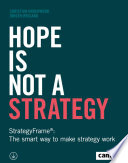

Strategic planning is essential for any organization looking to achieve long-term success. The book emphasizes that merely hoping for success without a concrete plan is futile. It discusses the steps involved in creating a strategic plan, including setting clear objectives, identifying resources, understanding market dynamics, and establishing metrics for success. The author illustrates how organizations can benefit from a structured approach to planning, which involves analyzing their current situation, defining their vision, and outlining actionable steps to reach their goals. This process not only helps in anticipating challenges but also equips teams with a roadmap to navigate uncertainties.
Continue readingIn today's fast-paced business environment, relying on intuition alone is insufficient. The book highlights the significance of data-driven decision making, advocating for the use of analytics to inform strategies and actions. It explains various methods for collecting and analyzing data, including market research, customer feedback, and performance metrics. By leveraging data, organizations can make informed decisions that enhance their competitive edge. The author provides case studies demonstrating how companies that embrace data-driven strategies outperform their competitors, showcasing the transformative power of analytics in business.
Continue readingThe business landscape is constantly evolving, and the ability to adapt is crucial for survival. The book stresses the importance of being agile and responsive to change. It outlines strategies for fostering a culture of adaptability within organizations, such as encouraging innovation, embracing feedback, and being open to restructuring. The author argues that organizations must not only react to changes but also anticipate them, positioning themselves as leaders rather than followers. Real-world examples are provided to illustrate how companies that prioritize adaptability can seize opportunities and mitigate risks effectively.
Continue readingEffective leadership is pivotal in executing strategic plans. The book delves into the qualities of successful leaders, including vision, communication skills, and the ability to inspire teams. It discusses the importance of aligning team members with the organization's vision and ensuring that everyone understands their role in achieving strategic objectives. The author emphasizes that leaders must not only set the direction but also foster an environment of trust and collaboration. Through anecdotes and examples, the book illustrates how strong leadership can drive strategy execution and lead to organizational success.
Continue readingAccountability is a cornerstone of effective strategy execution. The book discusses the need for organizations to cultivate a culture where individuals take ownership of their responsibilities and outcomes. It outlines methods for establishing accountability, such as setting clear expectations, providing regular feedback, and recognizing achievements. The author argues that when team members feel accountable for their contributions, they are more likely to be engaged and motivated. The book includes case studies of organizations that have successfully implemented accountability measures, leading to improved performance and morale.
Continue readingThe journey towards success is ongoing, and organizations must commit to continuous improvement. The book emphasizes the importance of fostering a learning culture where employees are encouraged to develop their skills and knowledge. It discusses various approaches to continuous improvement, including regular training, mentorship programs, and knowledge sharing. The author highlights that organizations that prioritize learning are better equipped to innovate and adapt to changing circumstances. Real-life examples demonstrate how companies that embrace a mindset of continuous improvement achieve long-term success.
Continue readingThe final idea revolves around the necessity of measuring success and being willing to adjust strategies based on performance. The book discusses various metrics that organizations can use to evaluate their progress towards strategic goals. It emphasizes that measurement should not be a one-time event but an ongoing process that informs decision-making. The author encourages organizations to be flexible and willing to pivot when necessary, using data and feedback to refine their strategies. Case studies are provided to illustrate how companies that regularly assess their performance can adapt and thrive.
Continue reading